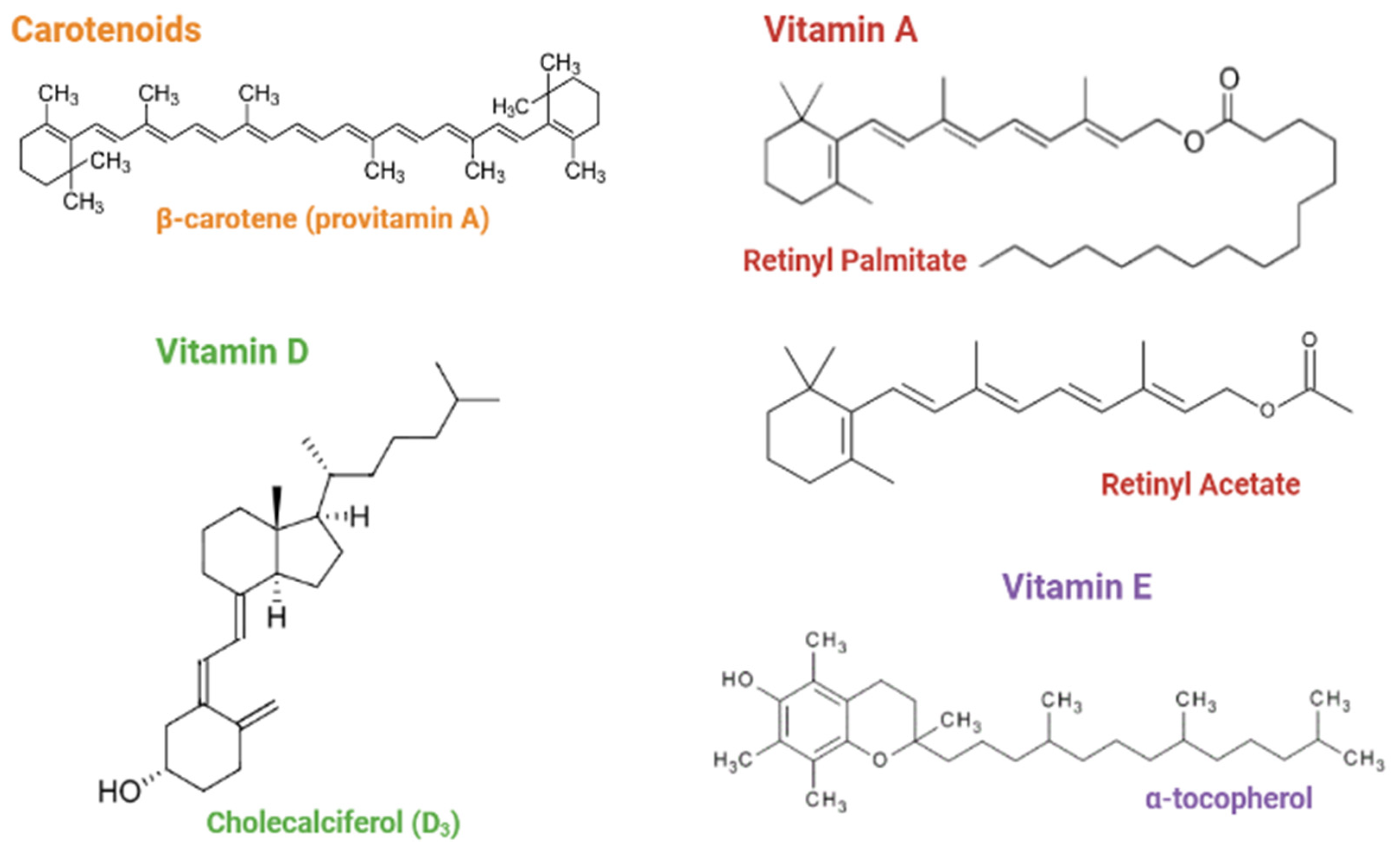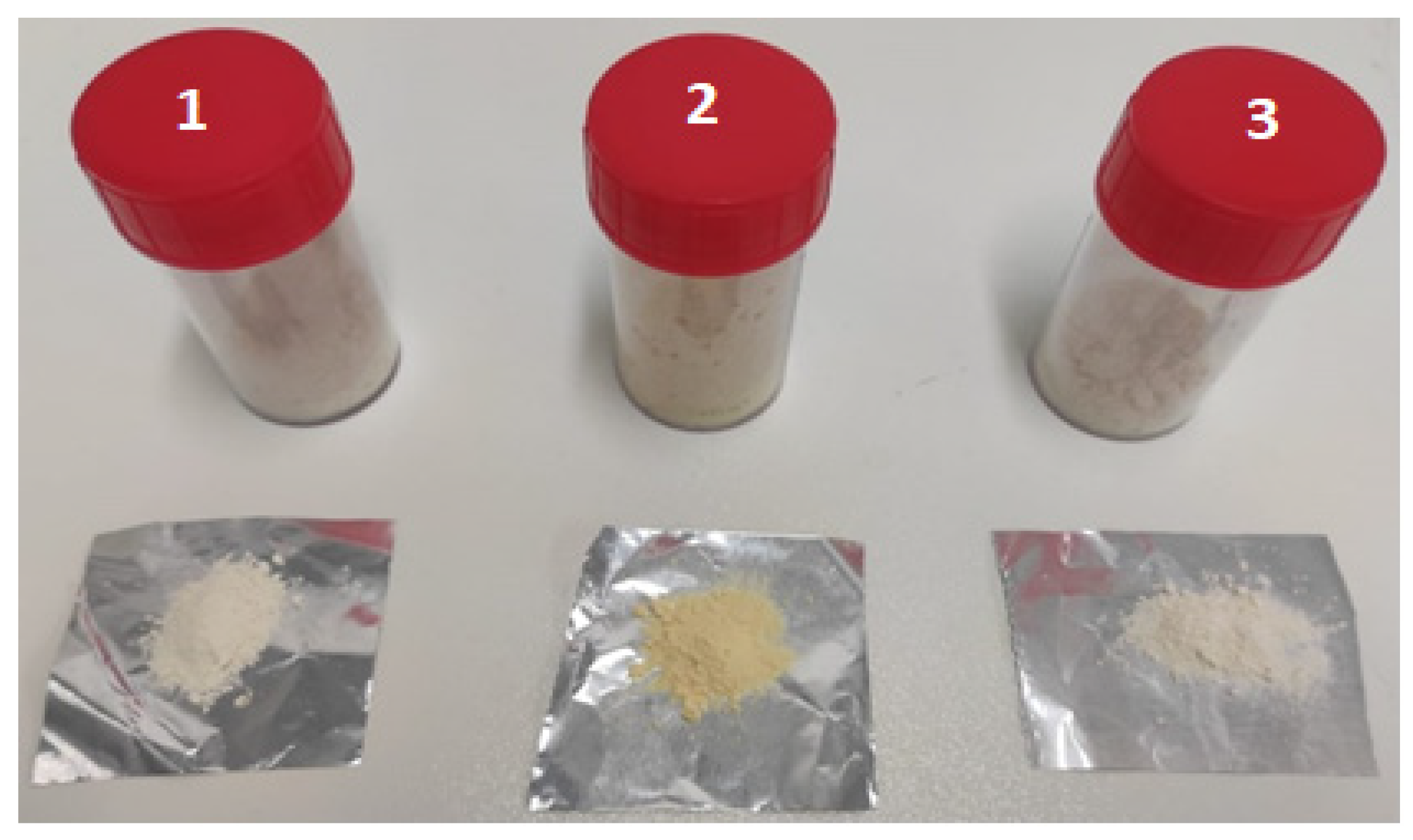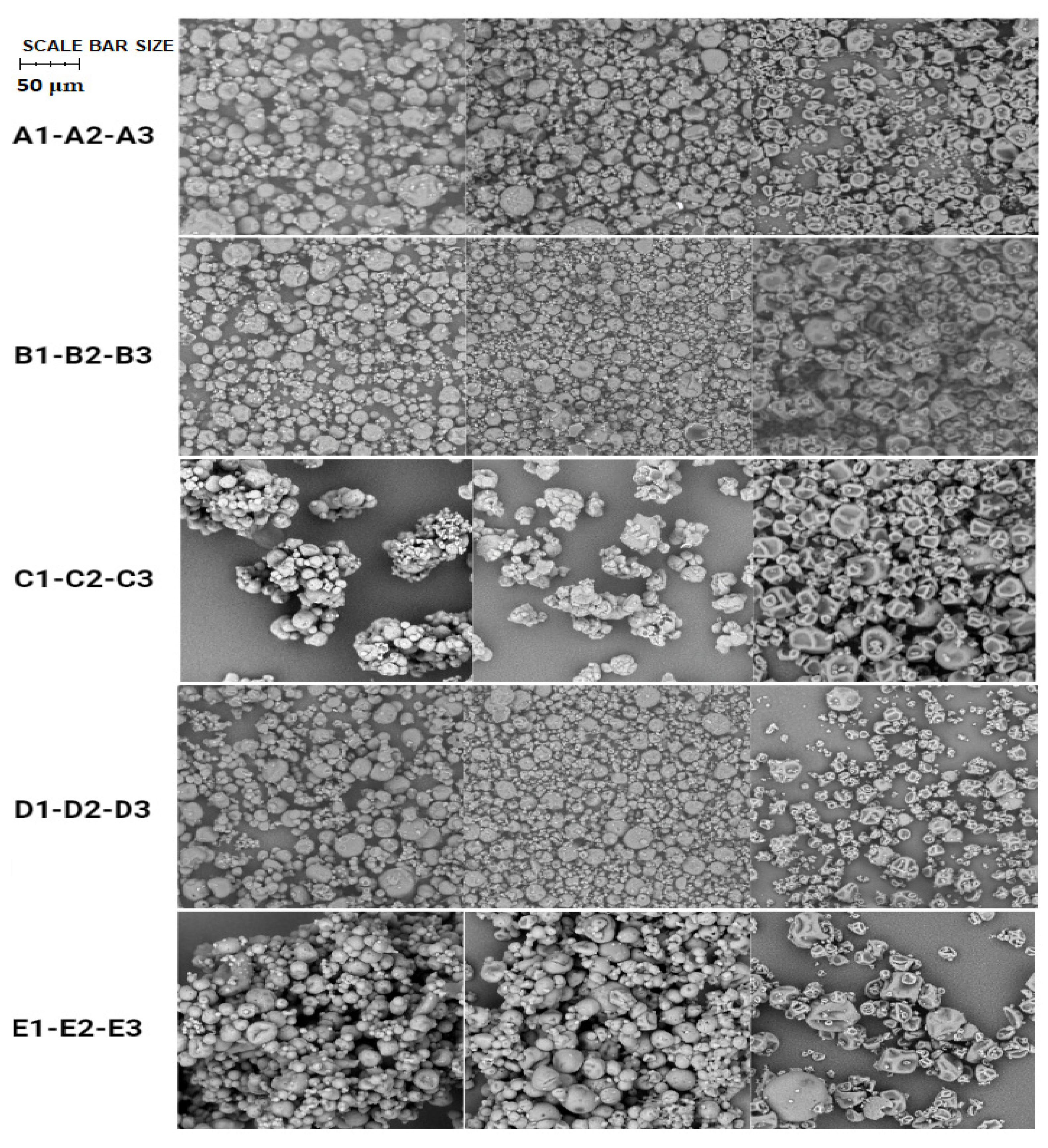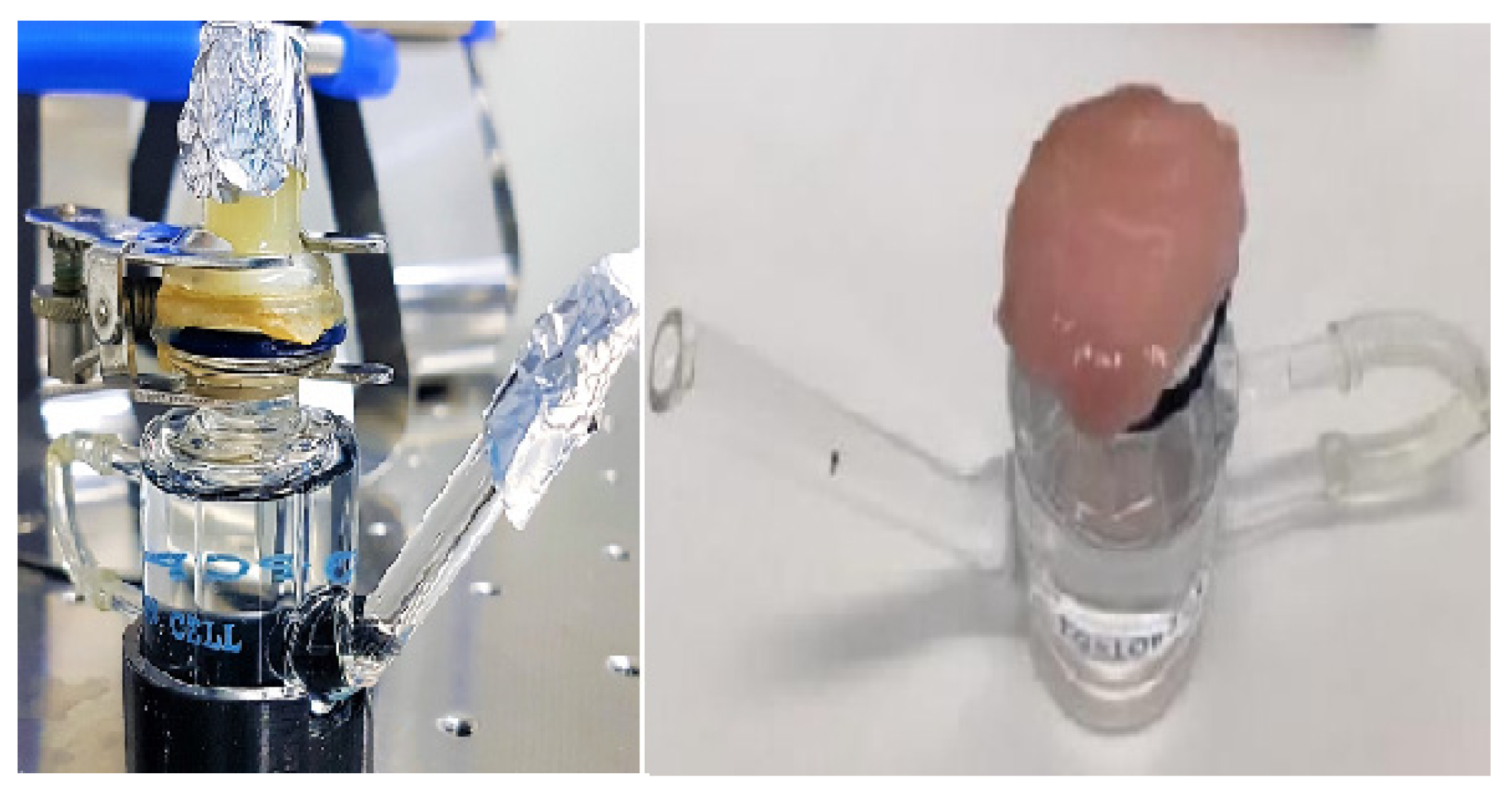Gastro-Resistant Microparticles Produced by Spray-Drying as Controlled Release Systems for Liposoluble Vitamins
Abstract
:1. Introduction
2. Materials and Methods
2.1. Materials
2.2. Methods
2.2.1. Preparation of the Gastro-Resistant Microparticle Formulations
2.2.2. Drug Loading Evaluation
2.2.3. In Vitro Dissolution Studies
2.2.4. Ex-Vivo Permeation Studies
2.2.5. Statistical Analysis
3. Results and Discussion
| Retinyl Palmitate cm−1 [26] | ||||
| 2922.11 | A1 cm−1 | A2 cm−1 | A3 cm−1 | Stretching C-H |
| 1734.66 | 2922.11 | 2922.11 | 2922.11 | Stretching C=O |
| 9632.65 | 1734.17 | 1734.17 | 1744.76 | Bending =CH |
| β-carotene cm−1 [27,28] | B1 cm−1 | B2 cm−1 | B3 cm−1 | |
| 3440.39 | 3400.85 | Stretching =CH | ||
| 2935.61 | 2935.13 | 2935.13 | 2935.13 | Stretching =CH |
| 1721.64 | 1735.82 | 1735.82 | 1721.64 | Stretching C=C |
| 1450.69 | 1449.73 | 1449.73 | 1450.69 | Bending C-H |
| Retinyl acetate cm−1 [29] | C1 cm−1 | C2 cm−1 | C3 cm−1 | |
| 3444.24 | Stretching =CH | |||
| 2926.45 | 2935.61 | 2936.09 | 2924.52 | Stretching C-H |
| 1624.73 | 1653.18 | Stretching C=O | ||
| 1436.71 | 1456.98 | 1457.44 | Stretching C=C | |
| Cholecalciferol cm−1 [30] | D1 cm−1 | D2 cm−1 | D3 cm−1 | |
| 3309.73 | Stretching O-H | |||
| 3077.35 | Stretching C-H | |||
| 2933.68 | 2935.13 | 2935.13 | 2933.68 | Stretching -CH2 |
| 1645.91 | 1645.91 | 1645.91 | 1645.91 | Stretching C=C |
| α-tocopherol cm−1 [31,32] | E1 cm−1 | E2 cm−1 | E3 cm−1 | |
| 3632.27 | Stretching =OH | |||
| 1420.32 | 1463.22 | 1462.74 | Bending -CH3 | |
| 1087.17 | 1087.17 | 1087.66 | 1070 | Plane Bending phenyl |
4. Conclusions
5. Patents
Supplementary Materials
Author Contributions
Funding
Institutional Review Board Statement
Informed Consent Statement
Data Availability Statement
Acknowledgments
Conflicts of Interest
References
- Combs, G.F., Jr.; McClung, J.P. The Vitamins: Fundamental Aspects in Nutrition and Health, 5th ed.; Academic Press: Cambridge, MA, USA, 2016. [Google Scholar]
- Goncalves, A.; Roi, S.; Nowicki, M.; Dhaussy, A.; Huertas, A.; Amiot, M.J.; Reboul, E. Fat-soluble vitamin intestinal absorption: Absorption sites in the intestine and interactions for absorption. Food Chem. 2015, 172, 155–160. [Google Scholar] [CrossRef]
- Rai, S.N.; Singh, P.; Steinbusch, H.W.; Vamanu, E.; Ashraf, G.; Singh, M.P. The Role of Vitamins in Neurodegenerative Disease: An Update. Biomedicines 2021, 9, 1284. [Google Scholar] [CrossRef]
- Stacchiotti, V.; Rezzi, S.; Eggersdorfer, M.; Galli, F. Metabolic and functional interplay between gut microbiota and fat-soluble vitamins. Crit. Rev. Food Sci. Nutr. 2020, 61, 3211–3232. [Google Scholar] [CrossRef]
- Harrison, E.H. Mechanisms of Transport and Delivery of Vitamin A and Carotenoids to the Retinal Pigment Epithelium. Mol. Nutr. Food Res. 2019, 63, e1801046. [Google Scholar] [CrossRef] [Green Version]
- Gul, K.; Tak, A.; Singh, A.K.; Singh, P.; Yousuf, B.; Wani, A.A. Chemistry, encapsulation, and health benefits of β-carotene—A review. Cogent Food Agric. 2015, 1, 1018696. [Google Scholar] [CrossRef]
- WHO. Global Prevalence of Vitamin A Deficiency in Populations at Risk 1995–2005 WHO Global Database on Vitamin A Deficiency. 2009. Available online: www.who.int/vmnis (accessed on 7 April 2022).
- Pludowski, P.; Holick, M.F.; Grant, W.B.; Konstantynowicz, J.; Mascarenhas, M.R.; Haq, A.; Povoroznyuk, V.; Balatska, N.; Barbosa, A.P.; Karonova, T.; et al. Vitamin D supplementation guidelines. J. Steroid Biochem. Mol. Biol. 2017, 175, 125–135. [Google Scholar] [CrossRef] [Green Version]
- Radicioni, M.; Caverzasio, C.; Rovati, S.; Giori, A.M.; Cupone, I.; Marra, F.; Mautone, G. Comparative Bioavailability Study of a New Vitamin D3 Orodispersible Film Versus a Marketed Oral Solution in Healthy Volunteers. Clin. Drug Investig. 2022, 42, 151–161. [Google Scholar] [CrossRef]
- Maqbool, M.A.; Aslam, M. Biological Importance of Vitamins for Human Health: A Review. Available online: https://www.researchgate.net/publication/325359151 (accessed on 9 March 2022).
- NIH. Vitamin E: Fact Sheet for Health Professionals; National Institutes of Health, Office of Dietary Supplements: Bethesda, MD, USA, 2019.
- Gonnet, M.; Lethuaut, L.; Boury, F. New trends in encapsulation of liposoluble vitamins. J. Control. Release 2010, 146, 276–290. [Google Scholar] [CrossRef]
- De Mohac, L.M.; Caruana, R.; Cavallaro, G.; Giammona, G.; Licciardi, M. Spray-Drying, Solvent-Casting and Freeze-Drying Techniques: A Comparative Study on their Suitability for the Enhancement of Drug Dissolution Rates. Pharm. Res. 2020, 37, 1–11. [Google Scholar] [CrossRef]
- Espinosa-Andrews, H.; Morales-Hernández, N.; García-Márquez, E.; Rodríguez-Rodríguez, R. Development of fish oil microcapsules by spray drying using mesquite gum and chitosan as wall materials: Physicochemical properties, microstructure, and lipid hydroperoxide concentration. Int. J. Polym. Mater. Polym. Biomater. 2022, 1–10. [Google Scholar] [CrossRef]
- De Mohac, L.M.; Caruana, R.; Pavia, F.C.; Cavallaro, G.; Giammona, G.; Licciardi, M. Multicomponent solid dispersion as a formulation strategy to improve drug permeation: A case study on the anti-colorectal cancer irinotecan. J. Drug Deliv. Sci. Technol. 2019, 52, 346–354. [Google Scholar] [CrossRef]
- Madureira, A.R.; Pereira, C.I.; Gomes, A.M.P.; Pintado, M.E.; Xavier Malcata, F. Bovine whey proteins—Overview on their main biological properties. Food Res. Int. 2007, 40, 1197–1211. [Google Scholar] [CrossRef]
- Caruana, R.; Montalbano, F.; Zizzo, M.G.; Puleio, R.; Caldara, G.; Cicero, L.; Cassata, G.; Licciardi, M. Enhanced anticancer effect of quercetin microparticles formulation obtained by spray drying. Int. J. Food Sci. Technol. 2021, 57, 2739–2746. [Google Scholar] [CrossRef]
- Mohammadian, M.; Moghaddam, A.D.; Sharifan, A.; Dabaghi, P.; Hadi, S. Nanocomplexes of whey protein fibrillar aggregates and quercetin as novel multi-functional biopolymeric ingredients: Interaction, chemical structure, and bio-functionality. J. Iran. Chem. Soc. 2020, 17, 2481–2492. [Google Scholar] [CrossRef]
- Ha, H.-K.; Rankin, S.A.; Lee, M.-R.; Lee, W.-J. Development and Characterization of Whey Protein-Based Nano-Delivery Systems: A Review. Molecules 2019, 24, 3254. [Google Scholar] [CrossRef] [Green Version]
- Diarrassouba, F.; Garrait, G.; Remondetto, G.; Alvarez, P.; Beyssac, E.; Subirade, M. Improved bioavailability of vitamin D3 using a β-lactoglobulin-based coagulum. Food Chem. 2015, 172, 361–367. [Google Scholar] [CrossRef]
- de Mohac, L.M.; Raimi-Abraham, B.; Caruana, R.; Gaetano, G.; Licciardi, M. Multicomponent solid dispersion a new generation of solid dispersion produced by spray-drying. J. Drug Deliv. Sci. Technol. 2020, 57, 101750. [Google Scholar] [CrossRef]
- Prinn, K.B.; Costantino, H.R.; Tracy, M. Statistical Modeling of protein spray drying at the lab scale. AAPS PharmSciTech 2002, 3, 32–39. [Google Scholar] [CrossRef] [Green Version]
- Sosnik, A.; Seremeta, K.P. Advantages and challenges of the spray-drying technology for the production of pure drug particles and drug-loaded polymeric carriers. Adv. Colloid Interface Sci. 2015, 223, 40–54. [Google Scholar] [CrossRef]
- Paudel, A.; Ayenew, Z.; Worku, Z.A.; Meeus, J.; Guns, S.; Van den Mooter, G. Manufacturing of solid dispersions of poorly water soluble drugs by spray drying: Formulation and process considerations. Int. J. Pharm. 2013, 453, 253–284. [Google Scholar] [CrossRef]
- Bharate, S.S.; Bharate, S.B.; Bajaj, A.N. Incompatibilities of Pharmaceutical Excipients with Active Pharmaceutical Ingre-dients: A Comprehensive Review. J. Excip. Food Chem. 2010, 1, 3–26. [Google Scholar]
- Vilanova, N.; Solans, C. Vitamin A Palmitate–β-cyclodextrin inclusion complexes: Characterization, protection and emulsification properties. Food Chem. 2015, 175, 529–535. [Google Scholar] [CrossRef]
- Niu, H.; Chen, W.; Chen, W.; Yun, Y.; Zhong, Q.; Fu, X.; Chen, H.; Liu, G. Preparation and Characterization of a Modified-β-Cyclodextrin/β-Carotene Inclusion Complex and Its Application in Pickering Emulsions. J. Agric. Food Chem. 2019, 67, 12875–12884. [Google Scholar] [CrossRef]
- Wang, M.; Fu, Y.; Chen, G.; Shi, Y.; Li, X.; Zhang, H.; Shen, Y. Fabrication and characterization of carboxymethyl chitosan and tea polyphenols coating on zein nanoparticles to encapsulate β-carotene by anti-solvent precipitation method. Food Hydrocoll. 2018, 77, 577–587. [Google Scholar] [CrossRef]
- Rockley, N.L.; Halley, B.A.; Rockley, M.G.; Nelson, E.C. Infrared spectroscopy of retinoids. Anal. Biochem. 1983, 133, 314–321. [Google Scholar] [CrossRef]
- Sagar, T.; Yogesh, S.; Rawat, S.S.; Satish, N. Formulation development & evaluation of effervescent tablet of alendronate sodium with vitamin d3. J. Drug Deliv. Ther. 2013, 3, 65. Available online: http://jddtonline.info (accessed on 15 April 2022).
- Silva, S.D.; Rosa, N.F.; Ferreira, A.; Boas, L.V.; Bronze, M. Rapid Determination of α-Tocopherol in Vegetable Oils by Fourier Transform Infrared Spectroscopy. Food Anal. Methods 2008, 2, 120–127. [Google Scholar] [CrossRef] [Green Version]
- Man, Y.C.; Ammawath, W.; Mirghani, M. Determining α-tocopherol in refined bleached and deodorized palm olein by Fourier transform infrared spectroscopy. Food Chem. 2005, 90, 323–327. [Google Scholar] [CrossRef]
- Yazdani, M.; Tavakoli, O.; Khoobi, M.; Wu, Y.S.; Faramarzi, M.A.; Gholibegloo, E.; Farkhondeh, S. Beta-carotene/cyclodextrin-based inclusion complex: Improved loading, solubility, stability, and cytotoxicity. J. Incl. Phenom. Macrocycl. Chem. 2021, 102, 55–64. [Google Scholar] [CrossRef]
- Li, X.; Lin, L.; Zhu, Y.; Liu, W.; Yu, T.; Ge, M. Preparation of ultrafine fast-dissolving cholecalciferol-loaded poly(vinyl pyrrolidone) fiber mats via electrospinning. Polym. Compos. 2013, 34, 282–287. [Google Scholar] [CrossRef]
- Curcio, C.; Greco, A.S.; Rizzo, S.; Saitta, L.; Musumeci, T.; Ruozi, B.; Pignatello, R. Development, Optimization and Characterization of Eudraguard ®-based Microparticles for Colon Delivery. Pharmaceuticals 2020, 13, 131. [Google Scholar] [CrossRef]
- Ravikumar, R.; Ganesh, M.; Ubaidulla, U.; Choi, E.Y.; Jang, H.T. Preparation, characterization, and in vitro diffusion study of nonwoven electrospun nanofiber of curcumin-loaded cellulose acetate phthalate polymer. Saudi Pharm. J. 2017, 25, 921–926. [Google Scholar] [CrossRef]
- Azarmi, S.; Roa, W.; Löbenberg, R. Current perspectives in dissolution testing of conventional and novel dosage forms. Int. J. Pharm. 2007, 328, 12–21. [Google Scholar] [CrossRef]
- Zimet, P.; Livney, Y.D. Beta-lactoglobulin and its nanocomplexes with pectin as vehicles for ω-3 polyunsaturated fatty acids. Food Hydrocoll. 2009, 23, 1120–1126. [Google Scholar] [CrossRef]







| Batches | Yield% ± SD | DL% ± SD | EE% ± SD |
|---|---|---|---|
| A1 | 52.8 ± 0.2 | 3.1 ± 0.2 | 34.2 ± 0.2 |
| B1 | 63.9 ± 0.3 | 3.5 ± 0.3 | 41.3 ± 0.3 |
| C1 | 43.2 ± 0.1 | 1.6 ± 0.1 | 17.1 ± 0.4 |
| D1 | 56.7 ± 0.1 | 1.4 ± 0.1 | 77.7 ± 0.1 |
| E1 | 47.3 ± 0.4 | 0.6 ± 0.1 | 25.9 ± 0.2 |
| A2 | 45.1 ± 0.2 | 0.5 ± 0.4 | 31.8 ± 0.2 |
| B2 | 66.2 ± 0.1 | 1.8 ± 0.2 | 20.2 ± 0.3 |
| C2 | 46.9 ± 0.5 | 0.6 ± 0.3 | 43.3 ± 0.5 |
| D2 | 45.2 ± 0.3 | 1.6 ± 0.2 | 83.6 ± 0.3 |
| E2 | 52.7 ± 0.2 | 4.2 ± 0.3 | 71.9 ± 0.2 |
| A3 | 57.9 ± 0.2 | 1.1 ± 0.1 | 17.1 ± 0.1 |
| B3 | 65.2 ± 0.1 | 1.1 ± 0.2 | 18.1 ± 0.1 |
| C3 | 44.1 ± 0.1 | 1.8 ± 0.4 | 30.2 ± 0.4 |
| D3 | 48.3 ± 0.3 | 0.5 ± 0.5 | 39.8 ± 0.3 |
| E3 | 44.2 ± 0.4 | 2.4 ± 0.3 | 81.7 ± 0.5 |
| Batches | Average Diameter (μm) ± SD |
|---|---|
| A1 | 10.4 ± 2.3 |
| B1 | 12.1 ± 3.3 |
| C1 | 8.8 ± 3.2 |
| D1 | 13.6 ± 3.7 |
| E1 | 10.8 ± 4.4 |
| A2 | 11.5 ± 3.4 |
| B2 | 8.9 ± 2.3 |
| C2 | 9.2 ± 4.5 |
| D2 | 12.2 ± 2.9 |
| E2 | 10.6 ± 4.1 |
| A3 | 14.9 ± 4.3 |
| B3 | 6.7 ± 2.5 |
| C3 | 11.8 ± 3.9 |
| D3 | 10.1 ± 2.5 |
| E3 | 10.7 ± 4.9 |
| Batches | Δm (mg) ± SD | Δm (%) ± SD |
|---|---|---|
| A1 | 0.481 ± 0.153 | 3.12 ± 0.54 |
| A2 | 0.453 ± 0.165 | 3.41 ± 0.42 |
| A3 | 0.411 ± 0.189 | 3.22 ± 0.32 |
| B1 | 0.347 ± 0.254 | 2.57 ± 0.71 |
| B2 | 0.283 ± 0.145 | 2.23 ± 0.69 |
| B3 | 0.335 ± 0.187 | 2.42 ± 0.85 |
| C1 | 0.355 ± 0.211 | 2.91 ± 0.33 |
| C2 | 0.468 ± 0.133 | 3.71 ± 0.25 |
| C3 | 0.463 ± 0.147 | 3.89 ± 0.27 |
| D1 | 0.461 ± 0.188 | 3.29 ± 0.22 |
| D2 | 0.511 ± 0.221 | 3.78 ± 0.31 |
| D3 | 0.481 ± 0.198 | 3.45 ± 0.46 |
| E1 | 0.394 ± 0.155 | 3.39 ± 0.55 |
| E2 | 0.503 ± 0.132 | 3.98 ± 0.41 |
| E3 | 0.386 ± 0.119 | 3.78 ± 0.39 |
Publisher’s Note: MDPI stays neutral with regard to jurisdictional claims in published maps and institutional affiliations. |
© 2022 by the authors. Licensee MDPI, Basel, Switzerland. This article is an open access article distributed under the terms and conditions of the Creative Commons Attribution (CC BY) license (https://creativecommons.org/licenses/by/4.0/).
Share and Cite
Terracina, F.; Caruana, R.; Bonomo, F.P.; Montalbano, F.; Licciardi, M. Gastro-Resistant Microparticles Produced by Spray-Drying as Controlled Release Systems for Liposoluble Vitamins. Pharmaceutics 2022, 14, 1480. https://doi.org/10.3390/pharmaceutics14071480
Terracina F, Caruana R, Bonomo FP, Montalbano F, Licciardi M. Gastro-Resistant Microparticles Produced by Spray-Drying as Controlled Release Systems for Liposoluble Vitamins. Pharmaceutics. 2022; 14(7):1480. https://doi.org/10.3390/pharmaceutics14071480
Chicago/Turabian StyleTerracina, Francesca, Roberto Caruana, Francesco Paolo Bonomo, Francesco Montalbano, and Mariano Licciardi. 2022. "Gastro-Resistant Microparticles Produced by Spray-Drying as Controlled Release Systems for Liposoluble Vitamins" Pharmaceutics 14, no. 7: 1480. https://doi.org/10.3390/pharmaceutics14071480






